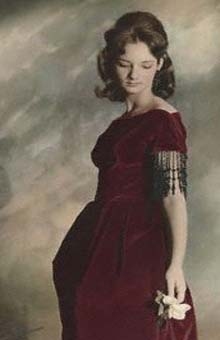Inveraray Castle is in Argyll, a Scottish district, and located in sight of Loch Fyne. This is western Scotland, and Inveraray Castle was an 18th century construction designed as the home of the Duke of Argyll. And his descendents count it as home today. Here are two lovely pictures of the current Dowager Duchess. She married the 12th Duke on July 4, 1964.

Iona Mary Campbell, nee Colquhoun, was born June 22, 1945. I wish I knew when the following photo was taken:

but the photo is not very old. The tiara is Victorian, according to the Duchess and this probably means it belonged to the wife of the 9th Duke, a daughter of Queen Victoria. In 2006 the Dowager Duchess found the luggage containing some precious jewelry, including the tiara, had been lost. She had checked her bags for a flight from London to Glasgow. She notified the airlines and an art theft organization. It was only in 2012 that the tiara was recovered.
Argyll retains its wild beauty today. But not its wild cats. Here are some accounts of the area in the 19th century, and we are quoting A Vertebrate fauna of Argyll and the inner Hebrides the work of John Alexander Harvie-Brown, and Thomas E. Buckley (1892). This book concerns the fauna of Argyll and the inner Hebrides, and we learn, regarding Felis catus, the wild cat, [similar in size to our domestic cats but impossible of being tamed] that it is:
Totally absent from the Isles, and has become much restricted in its distribution on the mainland of Scotland of late years. In 1880 the late Mr. E. R. Alston says: "I believe that none exist now south of the northern districts of Argyll and Perthshire."Although not extinct in the county of Argyll, it had receded by 1881-82 to the more mountainous districts. ...The last Wild Cat seen in the district of Loch Awe was near Kilchurn Castle, where one was trapped by Donald M.Kercher, gamekeeper to the Earl of Breadalbane, in Letter Wood, about 1864. It is said to have measured 3 feet 11 inches from the nose to the tip of the tail! We heard of one also, trapped at Inveraray Castle, about 1828, by Mr. George Brand, ... keeper there, who tracked it in the snow for several miles. ... [T]hree Wild Cats were seen in 1871 crossing from Suinart into Ardnamurchan. Two of these were trapped afterwards by Mr. Simon Ross (see Vermin Lists), in April 1872, near Glenborrodale, and the third was killed further west by John Cameron, another keeper, in June of the same year. None have been seen or heard of since. ...In Lochiel it had long been the practice to keep down the vermin, a clause being inserted in all Lochiel's leases binding his tenants to pay the fox-hunter for killing vermin, amongst which Wild Cats are named; and many leases of Highland estates bear similar testimony to their presence, and the necessity of preventing them from becoming too numerous. In Suinart, in 1879, Mr. Murray, gamekeeper, killed a fine Wild Cat close to Strontian House on February 14th. It had purloined a hen, and he tracked it in the snow, found the remains of the fowl, set his traps, and secured it by 10 o'clock the same night. In 1878 Mr. Murray captured another, also in February, in Carnbawn Wood, which had committed great havoc amongst the people's poultry-yards. He got another in 1874 in Airenndale Wood. A very fine one was caught by a shepherd, living at Ranachan, in Camusain Wood, on the north side of Loch Suinart, which was sent alive to Glasgow..."Since the above was first written in 1881-82, there is not much to add to the records; but the following, which was withheld from ... [ a published resource] purposely, as at that time giving too great publicity to localities, may now, we believe, be safely alluded to. The Rev. Alexander Stewart wrote ... "In 1875 the lady of a neighbouring proprietor applied to me for assistance in procuring from fifteen to twenty Wild Cat skins for a lining to a gentleman's 'dreadnought,' or ulster. In a few weeks, by purchase or otherwise, the requisite number was obtained. Most were, no doubt, killed between 1872 and 1875, ... "An examination of the Lists of Vermin which we have received still further shows that the present limits of the species are receding from our area towards the north; and we are informed by the Rev. Charles MacDonald, who has resided for many years at Mingarry, Loch Shiel, that even in that district now (1888), and the northern parts of our area, "the Wild Cat is almost exterminated; but within the last thirty years," continues the Rev. Charles MacDonald, "I have seen some magnificent specimens trapped within a quarter of a mile of my house. Two of these were males. One of them killed in a single night nearly all my poultry, which had been roosting in the trees close to us."....A litter was destroyed by the keeper, M.Laren, on Meoble in 1891. One skin was seen drying outside a keeper's cottage at Irvine, Keepers report a few still found in lower Glen Affaric (Doncaster)....
So we may conclude that while the 19th century Argylls were collecting silver, the wild cats were collecting lead.
No comments:
Post a Comment